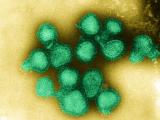Feb 17, 2011 (CIDRAP News) – A cell-culture-derived influenza vaccine made by Baxter Bioscience provided about 71% protection against confirmed flu cases in young adults who participated in a large US clinical trial, a level similar to what has been seen with traditional egg-based vaccines, according to a report in The Lancet.
The authors, from Baxter and Dynport Vaccine Co., say the trial is the first to demonstrate the clinical efficacy of a flu vaccine derived from Vero cells, which come from African green monkeys. They say Vero cells are the only cell line that has "universal regulatory acceptance."
Production of flu vaccines in mammalian cell cultures is said to have several advantages, including speed and flexibility, over the traditional process of growing them in eggs. Cell-based flu vaccines have been licensed in Europe, but none have yet been approved in the United States.
In the Baxter trial, which was financed by the US government's Biomedical Advanced Research and Development Authority (BARDA), Baxter's trivalent Vero-cell-based vaccine was tested against a placebo vaccine for preventing confirmed flu infection in adults aged 18 to 49 years. The researchers also assessed the correlation between vaccine efficacy and flu antibody levels.
The team recruited and included in their analysis 7,236 volunteers at 36 centers around the country, who were randomly assigned to receive the vaccine or a placebo during the 2008-09 flu season.
Twenty-three flu cases (0.6%) were confirmed among the 3,619 participants who received the flu vaccine, versus 80 cases (2.2%) among the 3,617 placebo recipients. That translated into an efficacy of 71.5% (95% confidence interval, 54.7 to 82.1%). The numbers included all flu cases, regardless of whether they matched the flu strains used in the vaccine.
When the researchers counted only the flu infections matching the strains used in the vaccine, there were 13 cases (0.4%) among the vaccine recipients and 60 cases (1.7%) among the placebo group. That signaled 78.5% efficacy (95% CI, 60.8 to 88.2%) against the specific flu strains in the vaccine.
Fourteen of the 23 flu cases in the vaccine recipients and 56 of 80 in the placebo group involved the A/H1N1 subtype, which was predominant that year. Because there were so few cases of A/H3N2 or type B flu, and because the B strain in the vaccine did not match the circulating strain, the study did not demonstrate significant vaccine efficacy against those subtypes, the report says.
In addition, the vaccine was well-tolerated, with no serious adverse events reported.
The team used hemagglutination inhibition at baseline and 21 days after vaccination to assess the participants' antibody response to the H1N1 component of the vaccine. They say their results show that an antibody titer of 1:15 is a reliable indicator of protection by the Baxter vaccine and that there is no added protection at titers greater than 1:30.
The authors note that comparing different flu vaccine efficacy studies is difficult because of confounding factors, but say their results compare favorably with findings from other studies. They cite a meta-analysis of trials done in healthy adults from 1977 to 2009, which showed that trivalent inactivated vaccines were 73% efficacious when vaccine strains matched the circulating strains. Live attenuated vaccines were found to be 62% efficacious.
"These data suggest that the Vero-cell-derived influenza vaccine is at least as effective in preventing culture-confirmed influenza infection as inactivated and live attenuated egg-derived vaccines," the report says.
The results were similar to those reported last October in a large, three-country clinical trial of a cell-based flu vaccine made by Novartis. Tested during the 2007-08 flu season, that vaccine showed an efficacy of 69.5% against all circulating flu strains and 83.8% against the strains in the vaccine. The Novartis vaccine is grown in canine kidney cells.
In an accompanying commentary, W. Paul Glezen of Baylor College of Medicine in Houston writes that the greatest advantage of culture-grown flu antigens may lie in that this technology preserves the structure of the antibody-combining sites on the flu virus's hemagglutinin protein. Manipulation of human flu viruses to make them grow in eggs changes the hemagglutinin, and animal studies "suggest that the use of vaccine virus grown in mammalian cells could enhance protection after challenge with the human virus," Glezen says.
Despite the reported advantages of cell-based flu vaccines, not all vaccine companies are pursuing them. Sanofi Pasteur, a major supplier for the United States, abandoned development of cell-based flu vaccines in 2009. Company officials at the time said that a pilot vaccine that Sanofi developed offered no real clinical advantage and only a modest time savings and was expensive.
Barrett PN, Berezuk G, Fritsch F. Efficacy, safety, and immunogenicity of a Vero-cell-culture-derived trivalent influenza vaccine: a multicentre, double-blind, randomized, placebo-controlled trial. Lancet 2011; early online publication Feb 16 [Abstract]
See also:
Extract of accompanying Lancet commentary
Oct 6, 2010, CIDRAP News story "Trial answers some, not all, questions, on cell-based flu vaccines"




















